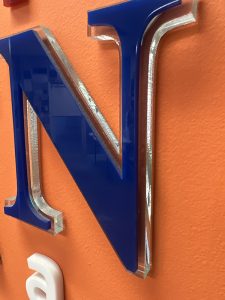All About Electric and Non-Electric Signs
Signs are an integral part of our daily lives, guiding us, informing us, and often leaving a lasting impression. Within the signage industry, there exists a fascinating dichotomy between Non-Electrical Signs and Electrical Signs, each with its unique design, manufacturing, and installation processes.
Electrical Signs: Illuminating Possibilities
Contrasting Non-Electrical Signs, Electrical Signs are designed to captivate attention through illuminated elements, utilizing electricity to light up and stand out.
 Our Electrical Signs Provide Diverse Designs
Our Electrical Signs Provide Diverse Designs
Electrical Signs offer a wide spectrum of designs.
- Channel Letters are three-dimensional signage often seen on storefronts, providing excellent visibility both day and night.
- Monument Signs are large, sturdy structures typically found in front of buildings or entrances, making a bold statement and enhancing brand presence.
- Pylon Signs are towering structures that grab attention from afar, commonly used near highways or high-traffic areas.
- Cabinet Signs feature illuminated panels and are versatile in their application, fitting various business needs.
The realm of Custom Signs in the electrical category allows for innovation, incorporating unique lighting elements and designs tailored to specific client requirements.
Precision Manufacturing Our Electrical Signs
Manufacturing Electrical Signs involves integrating lighting components and electrical systems into the sign structure. Precision is crucial in ensuring that lighting elements are properly installed, wiring is secure, and the sign meets safety standards. Advanced technology and skilled craftsmanship are employed to create durable and visually appealing electrical signs.
Skillful Installation Of Our Electrical Signs
Installing Electrical Signs requires expertise in handling electrical components safely. Professional installers ensure that electrical connections are properly established, and the sign is securely mounted or positioned for maximum visibility and impact.
Non-Electrical Signs: The Art of Simplicity
Non-Electrical Signs, also known as non-illuminated signs, are a versatile category of signage that doesn’t rely on electricity for illumination. These signs encompass a diverse range of designs and serve various purposes without the need for lighting elements.
 Design Variety
Design Variety
Non-Electrical Signs come in many forms.
- Flat Cut Out Letters, for instance, are precisely cut letters or shapes made from various materials such as wood, metal, or acrylic. These letters add a sophisticated touch to storefronts and interior spaces.
- Way Finding & Directional Signage, on the other hand, assists people in navigating through spaces, ensuring easy movement and clear guidance within buildings or public areas.
- Directory Signs serve as comprehensive lists, directing individuals to specific locations within larger spaces like malls or offices. Additionally, Construction Signage plays a vital role in safety by indicating restricted areas, safety guidelines, and warnings at construction sites.
- Aluminum Parking & Enforcement Signs are durable markers used to manage parking spaces efficiently.
Finally, the realm of Custom Signs allows for limitless creativity, enabling businesses to showcase their unique identity through tailor-made signage.
Manufacturing Expertise of Our Non Electrical Signs
The production of Non-Electrical Signs involves a meticulous process. Materials are carefully selected based on durability, appearance, and suitability for the intended purpose of the sign. Manufacturers utilize precision cutting and shaping techniques to create letters, shapes, or panels that form the sign. Craftsmanship and attention to detail play pivotal roles in ensuring that each sign meets quality standards.
Installation Process of our Non Electrical Signs
Installing Non-Electrical Signs requires accuracy and proper placement. Expert installers assess the environment and execute the installation process efficiently, ensuring the sign fits seamlessly into its designated space. Mounting, affixing, or positioning the sign in a visible and effective manner is crucial to its functionality and aesthetic appeal.
